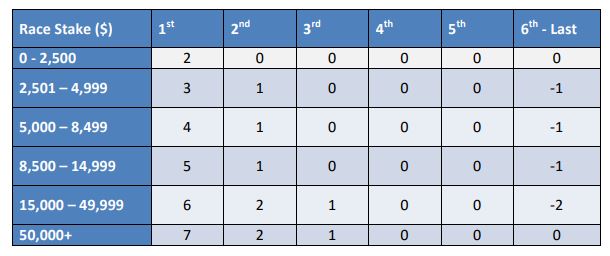When assessing harness racing form, having a basic knowledge on what the different classes and grades mean, will go a long way to helping understand how strong a race is and whether certain horses will measure up to that grade. We've explained how the class system works in Australian harness racing below.
Harness racing classes explained
There are three common letters that you will see when looking at a harness racing form guide. They will be:
- R = Restricted Class Wins
- C = Career Wins
- M = Metro Wins
A quick note is that these class levels are for pacers. We will explain later what trotters class levels are.
Based on the number of wins in each respective class, a horse will have their class assessment shown in the form guide. An example may be R4 C2, which means four wins in restricted grade and two in C-class races. Another example is C13 M2, which means 13 career class wins and two metro wins. There is a drop back rule that sees a horse drop a class assessment if they haven’t won after 10 consecutive races. For example, a horse that has lost 20-straight races and was previously a C4, will become a C2-assessed horse after the 20th defeat. Horses cannot drop back to become a C0, so they will drop as far back as a C1. The same applies for R and M class assessments; therefore, a horse that wins a metropolitan race will only ever become an M1 regardless of a long losing streak.
If a horse wins an M-class race, they will also receive a C-class penalty and R-class penalty, due to M-class being higher than C-class and R-class. If a horse wins a C-class race, it will also receive an R-class penalty for the same reason.
Some examples of classes that you will see for upcoming races are C0, C1-C2, C3-C4, C5+, M0, M1-M2, M3-M4 and M0+. We will analyse a couple of these classes. A C0 race is for horses that have not won a C-class race. A C3-C4 would see horses that are C3 and C4-assessed compete against one another. Fillies and mares receive a concession which means a C5 mare could contest the race. Concession drivers, which are similar to apprentice jockeys, can also claim a class which means a C5 male, or C6 female could enter a C3-C4 race as the driver is claiming a concession. An M0+ is a race for free-for-all pacers, also known as open-class. It means any M-class assessed horse can enter the race, but lower-class horses will likely be balloted from the race for better horses to compete.
Trotters will be distinguishable by the letter T. The classes work in the same way as the pacers, except you will see a T before them. Therefore, example assessments may be TR3, T1, TM0. You may have noticed that the C has been dropped from the middle one, and that is the case. Restricted race wins are TR, career wins are T instead of C and metro wins are TM.
A new ratings-based handicapping system is set to be introduced in July 2019. It has been tailored from the thoroughbred model which was introduced in 2006. Horses will begin their career with a rating of 50. The following matrix shows how many ratings points are added or deducted based on finishing position and race prize money (or stake).

We will provide an update once the new ratings-based handicapping system is in effect to explain how all of the classes work.
--



